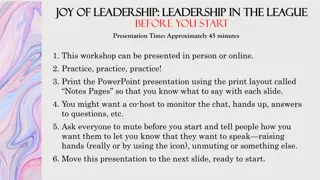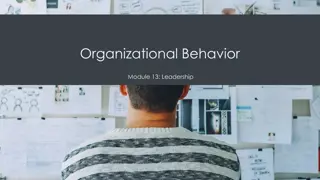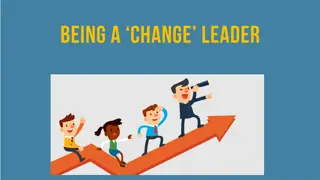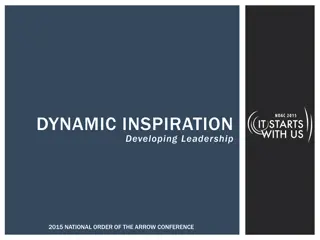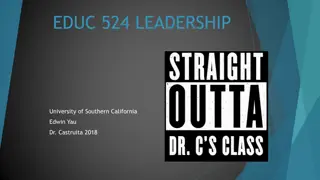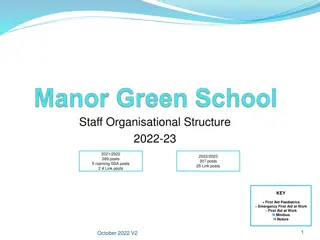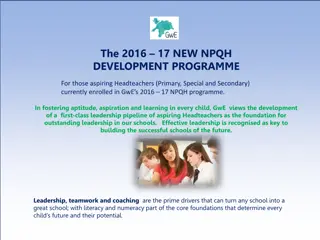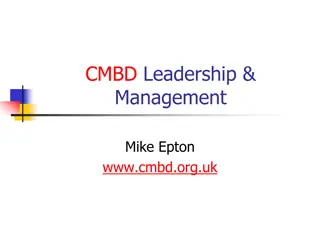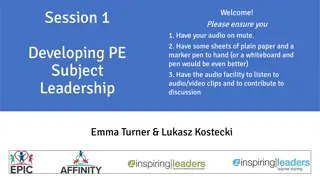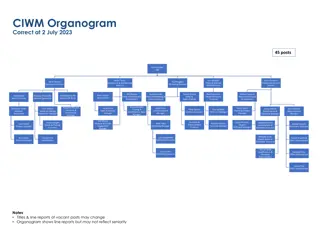Understanding Leadership Roles in NA Service Structure
The foundation of leadership in NA lies in the Steps, Traditions, and Concepts. Leaders play crucial roles in carrying the message of recovery, administering services, pooling resources, and ensuring the common welfare of NA worldwide. Effective leaders communicate vital information between service bodies, emphasizing integrity and effectiveness in their roles.
Download Presentation

Please find below an Image/Link to download the presentation.
The content on the website is provided AS IS for your information and personal use only. It may not be sold, licensed, or shared on other websites without obtaining consent from the author. Download presentation by click this link. If you encounter any issues during the download, it is possible that the publisher has removed the file from their server.
E N D
Presentation Transcript
The source for guidance on the roles, qualities, and practice of leadership in NA comes from our Steps, Traditions, and Concepts. Any discussion of leadership must start here and the foundation for success of any leader in NA must start with an understanding of our Steps, Traditions, and Concepts. WHAT ARE SOME LEADERSHIP QUALITIES?
Group Group Group Group Area Area Region
What are some of our responsibilities as leaders in the service structure? Group: * Carries the message of recovery directly to the suffering addict Area: * Administers the services of a local NA community Region: * Pools the experience and resources of areas and groups to address service issues. World Services: * Unifies and ensures the common welfare of NA worldwide
Some general ideas of important information to carry forward to other levels of the NA service structure: Meeting information: time, day, and place. Issues of concern or challenges to help other service bodies focus their efforts or to make informed decisions about service needed. Recent successes that others can learn from or use to be more effective. Input on issues as requested by other service bodies.
Some general ideas of important information to bring back to your group from other parts of the NA service structure: Anything that a service committee is asking guidance or input on. Financial information. Activities, events, or service efforts that need support.
Leaders within the NA service structure are responsible for carrying forward the needs and concerns of the fellowship, and for sharing their thoughts and ideas. To be an effective conduit of information, leaders must: Have a clear understanding of the roles and functions of the other parts of the service structure they are communicating with. Know what information is most essential to deliver to these service bodies and what information to take back to their own group from these service bodies. Deliver the information in the most efficient way possible
8th Concept: Our service structure depends on the integrity and effectiveness of our communications. Leaders in NA must be effective communicators at different levels: One-on-one individually: as a mentor or coach. Within a team: facilitator. Helps the group brainstorm ideas, solve problems, etc. Within the Service Structure: acts as a conduit of information between bodies of the service structure, making sure that everyone has the information, input, and feedback that they need to perform their functions.
Concept 7 tells us how important it is for a leader to generate dialog, discussion, and input within our service groups. As a facilitator a leader fosters group conscience to guide discussion and decision making. A leader must know how to build consensus and productively manage conflict within the group so that all points of view can be considered, but so that the group can ultimately make a decision.
Key Points: Set ground rules for discussions, including the idea that to make the best decision we need to consider and hear all points of view. When brainstorming, focus on solutions and prevent the group from evaluating the ideas presented, until it s time to make a decision. When the issue is controversial or when there is a lot of disagreement, ensure that comments focus on the issue, problem, or idea under discussion and not just individuals in the group.
Essential techniques to generate dialog and discussion: Create an environment that allows for open discussion. Make sure the topic or issue to be discussed is clear and understood by all. Keep the focus on the topic or issue. Allow enough time for the group to explore and discuss topic or issue before asking them to make a decision. Listen effectively to understand what is being said.
When its time to make a decision, leaders can use the following steps: Clarify the decision that needs to be made & the goal the group is trying to achieve by making the decision. Reflect on the input received and identify common thoughts or ideas. Build & evaluate solutions/options to address the issue. Choose the solutions/options that will best meet the group s goal. Prepare for action & implementation of the decision.
The Whole: How our actions as a service body support and impact NA as a whole. The Vision: How we are continually working toward our goals and the ultimate impact we strive for our vision, the reason we do what we do. The Future: How we can best meet the needs of our fellowship today, while anticipating and preparing for the needs we will have tomorrow. How we can make the Group, Area or Region more effective and more efficient in providing services.
What are the different ways we effectively communicate information in our service structure?
) WHAT IS OUR VISION?
Stay OPEN-MINDED LISTEN and SHARE the time Remember to PLAY WELL with others Don t forget WHY we re here! STAY FOCUSED on the subject at hand
NO KICKING, BITING, or SCRATCHING ALLOWED!!!
The Leader as a Facilitator Or The Leader as a Conduit of Information
Report Your Group s Results . . .
Leadership is a unique experience that has many rewards. As leaders you both embody the values of those you serve, and yet at the same time help shape those values by modeling good leadership. The personal rewards of taking on a leader role in NA are enormous and can be a major part of our continuing recovery.
Leadership is not a solo action. To be effective, leaders draw from the diverse talents & experiences of the group. Operating as a team has many benefits, such as: Builds Unity around a common purpose & vision Broadens the opportunities for service Develops future leaders


